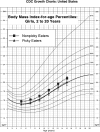Girls' picky eating in childhood is associated with normal weight status from ages 5 to 15 y
- PMID: 27797710
- PMCID: PMC5118736
- DOI: 10.3945/ajcn.116.142430
Girls' picky eating in childhood is associated with normal weight status from ages 5 to 15 y
Abstract
Background: Picky eating has been associated with lower weight status and limited food intake and variety in childhood. Little is known about how the persistence of picky eating in childhood is associated with changes in weight and food intake from childhood into adolescence.
Objective: We determined whether picky eating identified in childhood was related to growth, nutrition, and parental use of pressure over a 10-y period.
Design: Non-Hispanic white girls (n = 181) participated in a longitudinal study and were assessed biannually from ages 5 to 15 y. The Child Feeding Questionnaire was used to classify girls as persistent picky eaters or nonpicky eaters and to assess parental use of pressure to eat. Height and weight were measured to calculate body mass index (BMI) z scores at each occasion. Three 24-h dietary recalls obtained at each occasion were used to determine intakes of fruit and vegetables. With the use of repeated-measures analyses, differences between persistent picky eaters and nonpicky eaters in BMI z scores, dietary intake, and use of pressure were examined.
Results: From ages 5 to 15 y, persistent picky eaters (n = 33; 18%) had lower BMI (tracking at the 50th percentile) than did nonpicky eaters (n = 148; tracking at the 65th percentile) (P = 0.02). Persistent picky eaters were less likely to be overweight into adolescence. Both groups consumed less than the recommended amounts of fruit and vegetables, although persistent picky eaters had lower intakes of vegetables than did nonpicky eaters at all time points (P = 0.02). Persistent picky eaters also received higher amounts of pressure (P = 0.01).
Conclusions: Findings that persistent picky eaters were within the normal weight range, were less likely to be overweight, and had similar fruit intakes to those of nonpicky eaters suggest that higher parental concerns about persistent picky eaters are unwarranted. All parents and children could benefit from evidence-based anticipatory guidance on alternatives to coercive feeding practices to increase fruit and vegetable consumption.
Keywords: children; diet; growth; picky eating; weight.
© 2016 American Society for Nutrition.
Figures


Similar articles
-
A Narrative Review of Childhood Picky Eating and Its Relationship to Food Intakes, Nutritional Status, and Growth.Nutrients. 2018 Dec 15;10(12):1992. doi: 10.3390/nu10121992. Nutrients. 2018. PMID: 30558328 Free PMC article. Review.
-
Parental pressure, dietary patterns, and weight status among girls who are "picky eaters".J Am Diet Assoc. 2005 Apr;105(4):541-8. doi: 10.1016/j.jada.2005.01.029. J Am Diet Assoc. 2005. PMID: 15800554 Free PMC article.
-
Macro- and micronutrient intakes in picky eaters: a cause for concern?Am J Clin Nutr. 2016 Dec;104(6):1647-1656. doi: 10.3945/ajcn.116.137356. Epub 2016 Nov 9. Am J Clin Nutr. 2016. PMID: 27935522 Free PMC article.
-
Diet at Age 10 and 13 Years in Children Identified as Picky Eaters at Age 3 Years and in Children Who Are Persistent Picky Eaters in A Longitudinal Birth Cohort Study.Nutrients. 2019 Apr 10;11(4):807. doi: 10.3390/nu11040807. Nutrients. 2019. PMID: 30974806 Free PMC article.
-
Picky eating in children: causes and consequences.Proc Nutr Soc. 2019 May;78(2):161-169. doi: 10.1017/S0029665118002586. Epub 2018 Nov 5. Proc Nutr Soc. 2019. PMID: 30392488 Free PMC article. Review.
Cited by
-
Assessing the Body Composition of "Picky Eaters" Using Body Impedance Analysis: An Experience From a Tertiary Care Center.Cureus. 2024 May 18;16(5):e60538. doi: 10.7759/cureus.60538. eCollection 2024 May. Cureus. 2024. PMID: 38887328 Free PMC article.
-
A Narrative Review of Childhood Picky Eating and Its Relationship to Food Intakes, Nutritional Status, and Growth.Nutrients. 2018 Dec 15;10(12):1992. doi: 10.3390/nu10121992. Nutrients. 2018. PMID: 30558328 Free PMC article. Review.
-
Relationship between Anthropometric Parameters and Sensory Processing in Typically Developing Brazilian Children with a Pediatric Feeding Disorder.Nutrients. 2021 Jun 30;13(7):2253. doi: 10.3390/nu13072253. Nutrients. 2021. PMID: 34208820 Free PMC article.
-
Optimal Protein Intake in Healthy Children and Adolescents: Evaluating Current Evidence.Nutrients. 2023 Mar 30;15(7):1683. doi: 10.3390/nu15071683. Nutrients. 2023. PMID: 37049523 Free PMC article. Review.
-
Feeding Difficulty Among Chinese Toddlers Aged 1-3 Years and Its Association With Health and Development.Front Pediatr. 2021 Nov 23;9:758176. doi: 10.3389/fped.2021.758176. eCollection 2021. Front Pediatr. 2021. PMID: 34888269 Free PMC article.
References
-
- Taylor CM, Wernimont SM, Northstone K, Emmett PM. Picky/fussy eating in children: review of definitions, assessment, prevalence and dietary intakes. Appetite 2015;95:349–59. - PubMed
Publication types
MeSH terms
Grants and funding
LinkOut - more resources
Full Text Sources
Other Literature Sources
Medical

